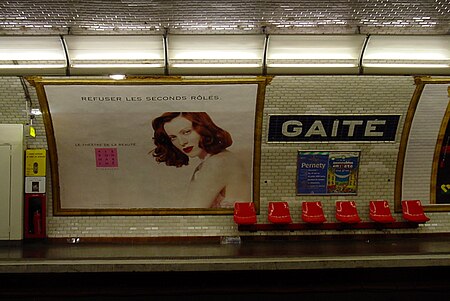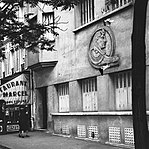Gaîté (Paris Métro)

Gaîté (French pronunciation: [ɡɛte]) is a station on line Line 13 of the Paris Métro in the 14th arrondissement. The station opened on 21 January 1937 as part of the original line 14 between Bienvenüe and Porte de Vanves. This line became part of line 13 on 9 November 1976. The station is named after the Rue de la Gaîté, which was a country road connecting Clamart with the Barrière du Montparnasse, a gate in the Wall of the Farmers-General at the intersection of the Boulevard Edgar-Quinet and the Rue du Montparnasse (the location of Edgar Quinet station), built between 1784 and 1791 by the Ferme générale, the corporation of tax farmers, to enforce the collection of taxes of goods, including wine, imported into Paris. Guinguettes, restaurants and theatres were built outside the wall, so they could avoid these taxes. "Gaîté" is an old French spelling of "gaiety", reflecting this trade. In 2021, it is planned to rename the station Gaîté - Joséphine Baker after American-born French dancer, singer, actress and World War II spy Joséphine Baker.
Excerpt from the Wikipedia article Gaîté (Paris Métro) (License: CC BY-SA 3.0, Authors, Images).Gaîté (Paris Métro)
Avenue du Maine, Paris Paris (Paris)
Geographical coordinates (GPS) Address Nearby Places Show on map
Geographical coordinates (GPS)
| Latitude | Longitude |
|---|---|
| N 48.838654 ° | E 2.322637 ° |
Address
Rue Vandamme
Avenue du Maine
75014 Paris, Paris (Paris)
Ile-de-France, France
Open on Google Maps










